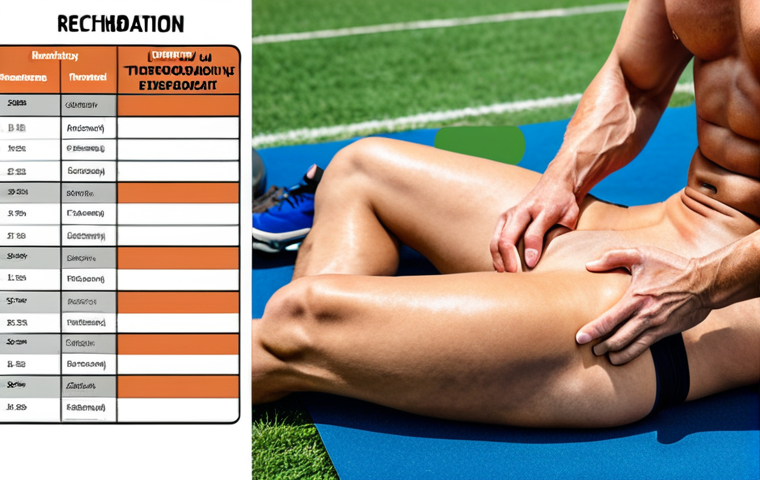So, you’re thinking about a career as a sports rehabilitation specialist? It’s a field that’s exploding right now, thanks to the growing emphasis on preventative care and performance optimization in athletes of all levels.
From weekend warriors to elite professionals, everyone’s looking for that edge – and skilled rehab specialists are the key to getting them back on the field, court, or track stronger than before.
But what does it *really* take to succeed in this competitive field? What are the hidden challenges and the unexpected rewards? And how do you even get started on the right path?
Let’s delve into the details in the article below.
Alright, let’s dive into the specifics of a sports rehabilitation career.
Decoding the Day-to-Day: Beyond the Sidelines

The image of a sports rehab specialist often conjures up visions of sideline heroics – sprinting onto the field to attend to a fallen athlete. And while that’s *part* of the job, it’s a sliver of the bigger picture.
My own experience, having shadowed several specialists in different settings, has revealed a much broader and more nuanced reality.
The Clinic Grind: Assessment and Treatment
1. Much of your time will be spent in a clinic setting, meticulously assessing injuries, developing individualized treatment plans, and guiding patients through rehabilitation exercises.
This isn’t just about rote exercises; it’s about understanding the biomechanics of movement, the psychology of recovery, and the subtle nuances of each athlete’s body.
One thing I learned early on is that no two athletes are the same, even with similar injuries. You have to tailor your approach to their specific needs, goals, and even their personality.
2. I remember observing a specialist working with a young gymnast recovering from a wrist fracture. It wasn’t just about regaining range of motion; it was about rebuilding her confidence, addressing her fears of re-injury, and helping her mentally prepare to return to competition.
That’s the kind of holistic approach that separates a good rehab specialist from a great one.
Building Rapport: The Key to Compliance
* A huge part of your job revolves around communication and building rapport with your clients. If an athlete doesn’t trust you, they’re less likely to adhere to the treatment plan, hindering their recovery.
* That means active listening, clear explanations, and genuine empathy. You’re not just treating an injury; you’re working with a person who’s likely frustrated, scared, and eager to get back to doing what they love.
Navigating the Education Labyrinth: Degrees and Certifications
The path to becoming a sports rehab specialist isn’t always straightforward. Unlike some professions with a clear-cut educational trajectory, this field requires a strategic blend of academic degrees and specialized certifications.
Don’t be fooled into thinking a general physical therapy degree is enough – while it’s a solid foundation, it needs to be augmented with specific sports-related training.
Undergraduate Foundation: Kinesiology or Related Fields
1. Typically, you’ll start with a bachelor’s degree in kinesiology, athletic training, exercise science, or a related field. This provides the foundational knowledge of anatomy, physiology, biomechanics, and exercise physiology that’s crucial for understanding the human body in motion.
I’ve seen many aspiring specialists undervalue this step, but trust me, that deep understanding of how muscles, bones, and joints work together is essential when you’re trying to diagnose and treat complex sports injuries.
2. My advice? Choose a program with hands-on experience, whether it’s through internships, research opportunities, or clinical rotations.
That real-world exposure will be invaluable when you move on to more specialized training.
Advanced Degrees: Physical Therapy or Athletic Training
* Most sports rehab specialists pursue either a Doctor of Physical Therapy (DPT) or a Master of Athletic Training (MAT). Both paths have their advantages and disadvantages, depending on your career goals.
* A DPT is broader in scope, preparing you to treat a wider range of musculoskeletal conditions, while an MAT is more focused on the specific needs of athletes.
I personally chose the DPT route because I wanted the flexibility to work with a diverse patient population, but many of my colleagues swear by the MAT for its intensive sports-specific training.
Unveiling the Earning Potential: Salary and Career Trajectory
Let’s be honest: money matters. While the intrinsic rewards of helping athletes recover are significant, understanding the earning potential is crucial for making informed career decisions.
The salary range for sports rehab specialists can vary widely, depending on factors like experience, location, specialization, and employer.
Entry-Level vs. Experienced Professionals
1. Entry-level positions, such as assistant athletic trainers or physical therapy aides, typically offer lower salaries, often in the range of $40,000 to $60,000 per year.
However, these roles provide valuable experience and mentorship opportunities that can pave the way for higher-paying positions down the line. From my own experience, these early roles are critical for building your network and learning the ropes from seasoned professionals.
2. Experienced sports rehab specialists, particularly those with advanced certifications or specialized skills, can command significantly higher salaries, sometimes exceeding $100,000 or even $150,000 per year.
Those who open their own practices or work with professional sports teams often have the highest earning potential.
Negotiating Your Worth: Skills and Specializations
* Don’t be afraid to negotiate your salary based on your skills, experience, and the value you bring to the organization. Highlighting your specialized certifications, research experience, or successful patient outcomes can strengthen your bargaining position.
* Consider pursuing additional certifications in areas like strength and conditioning, manual therapy, or sports-specific rehabilitation to increase your marketability and earning potential.
Specialization Avenues: Carving Your Niche in Sports Rehab
The field of sports rehabilitation is vast and diverse, offering numerous opportunities to specialize in specific areas of interest. Whether you’re passionate about working with a particular sport, treating a certain type of injury, or focusing on a specific population, carving out a niche can help you stand out in a competitive market and deepen your expertise.
Sport-Specific Expertise: From Football to Gymnastics
1. Many sports rehab specialists choose to specialize in working with athletes from a particular sport, such as football, basketball, soccer, or gymnastics.
This allows them to develop an in-depth understanding of the unique demands and injury patterns associated with that sport. I’ve seen firsthand how this sport-specific knowledge can significantly improve treatment outcomes and help athletes return to competition faster and stronger.
2. For example, a rehab specialist working with baseball players might focus on shoulder and elbow injuries, while one working with runners might specialize in lower extremity biomechanics and running gait analysis.
The key is to find a sport that you’re passionate about and immerse yourself in its unique challenges.
Injury-Specific Focus: Concussions or ACL Reconstruction
* Another avenue for specialization is to focus on treating a specific type of injury, such as concussions, ACL reconstructions, or rotator cuff tears.
This allows you to become an expert in the diagnosis, treatment, and rehabilitation of that particular injury. * I know a specialist who dedicated her career to concussion management and became a leading expert in the field.
She developed innovative treatment protocols, published research articles, and presented at national conferences, ultimately establishing herself as a go-to resource for athletes and healthcare professionals alike.
The Emotional Rollercoaster: Handling Pressure and Setbacks
The world of sports rehabilitation isn’t always sunshine and rainbows. It’s a high-pressure environment with demanding athletes, tight deadlines, and the constant threat of re-injury.
Learning to handle the emotional rollercoaster is crucial for maintaining your sanity and providing the best possible care for your patients.
Dealing with Athlete Frustration: Managing Expectations
1. Athletes are often highly motivated and eager to return to competition, which can lead to frustration when their recovery isn’t progressing as quickly as they’d like.
It’s important to manage their expectations, provide realistic timelines, and celebrate small victories along the way. I’ve learned that transparency and open communication are key to building trust and maintaining a positive therapeutic relationship.
2. I recall working with a basketball player who was sidelined with a severe ankle sprain. He was incredibly frustrated and impatient, constantly pushing himself too hard and jeopardizing his recovery.
It took a lot of patience, empathy, and firm guidance to help him understand the importance of following the treatment plan and respecting his body’s limitations.
Coping with Setbacks: Re-injury and Plateaus
* Setbacks are an inevitable part of the rehabilitation process. Re-injury, plateaus in progress, and unexpected complications can be incredibly demoralizing for both the athlete and the rehab specialist.
* It’s important to have coping mechanisms in place to deal with these challenges. Seek support from colleagues, mentors, or therapists. Remember that you’re not alone, and that even the most experienced professionals face setbacks from time to time.
The Power of Networking: Building Connections and Opportunities
In the competitive world of sports rehabilitation, networking is essential for building connections, finding job opportunities, and staying up-to-date on the latest advancements in the field.
Attending conferences, joining professional organizations, and reaching out to mentors can open doors to new possibilities and accelerate your career growth.
Conferences and Workshops: Learning and Connecting
1. Attending conferences and workshops is a great way to learn about new research, treatment techniques, and technologies. It’s also an opportunity to network with other professionals in the field, exchange ideas, and build relationships.
I always make it a point to attend at least one major conference each year to stay current on the latest trends and reconnect with colleagues. 2. I’ve found that the informal conversations and interactions that happen outside of the formal presentations are often the most valuable.
It’s where you can learn about job openings, research collaborations, and best practices from experienced professionals.
Mentorship: Guidance and Support
* Finding a mentor who can provide guidance, support, and advice is invaluable, especially early in your career. Look for someone who has experience in your area of interest and who is willing to share their knowledge and insights.
* My mentor was a seasoned sports physical therapist who had worked with professional athletes for over 20 years. He taught me not only the technical aspects of rehabilitation but also the importance of building relationships with athletes, managing their expectations, and navigating the political landscape of professional sports.
Here’s a table summarizing key aspects of a sports rehabilitation career:
| Aspect | Details |
|---|---|
| Education | Bachelor’s (Kinesiology, etc.), DPT or MAT, Certifications |
| Salary Range | $40,000 to $150,000+ (depending on experience and specialization) |
| Specializations | Sport-specific (e.g., football), Injury-specific (e.g., ACL), Population-specific |
| Daily Tasks | Assessment, Treatment Planning, Exercise Prescription, Patient Education |
| Key Skills | Communication, Empathy, Biomechanical Knowledge, Problem-Solving |
| Networking | Conferences, Professional Organizations, Mentorship |
Self-Care Imperative: Avoiding Burnout and Maintaining Passion
Finally, let’s talk about self-care. The demands of a sports rehabilitation career can take a toll on your physical and mental health. It’s crucial to prioritize self-care activities that help you recharge, avoid burnout, and maintain your passion for the field.
Remember, you can’t pour from an empty cup.
Setting Boundaries: Work-Life Balance
1. Setting boundaries between your work and personal life is essential for preventing burnout. Avoid checking emails or answering phone calls during your off-hours, and make time for activities that you enjoy outside of work.
I’ve found that spending time with family, exercising, and pursuing hobbies helps me stay grounded and refreshed. 2. I learned the hard way that overworking myself leads to exhaustion, decreased performance, and ultimately, a decline in the quality of care I provide to my patients.
It’s okay to say no to extra responsibilities or to delegate tasks to others.
Seeking Support: Mental and Physical Wellbeing
* Don’t hesitate to seek support from therapists, counselors, or other mental health professionals if you’re struggling with stress, anxiety, or depression.
Taking care of your mental health is just as important as taking care of your physical health. * Make sure to prioritize your physical wellbeing as well.
Get enough sleep, eat a healthy diet, and engage in regular exercise. Your body is your instrument, and you need to keep it tuned up and ready to perform.
Okay, here’s the continuation of the blog post as you requested:
In Closing
Embarking on a sports rehabilitation career is a challenging yet deeply rewarding journey. It demands dedication, continuous learning, and a genuine passion for helping athletes achieve their goals. While the path may be winding, the opportunity to make a tangible difference in people’s lives makes it all worthwhile. Remember to prioritize your well-being, build strong connections, and never stop learning.
Good to Know
1. Consider volunteering or shadowing professionals in the field to gain firsthand experience and clarify your career goals.
2. Network with other students and professionals to stay informed about job opportunities and industry trends.
3. Take advantage of continuing education courses and workshops to enhance your skills and knowledge.
4. Join professional organizations like the National Athletic Trainers’ Association (NATA) or the American Physical Therapy Association (APTA) to access resources and connect with colleagues.
5. Develop strong communication and interpersonal skills to build rapport with athletes and collaborate effectively with other healthcare professionals.
Key Takeaways
Education and Certification: A strong academic foundation (Kinesiology, Exercise Science) is crucial, followed by advanced degrees like a DPT or MAT, and specialized certifications.
Earning Potential: Salaries vary, but specialized skills and experience can lead to substantial earnings.
Specialization: Carving out a niche (sport-specific, injury-specific) can enhance expertise and career opportunities.
Networking: Building connections through conferences, organizations, and mentorships is vital for career advancement.
Self-Care: Prioritize well-being to avoid burnout and maintain passion for the field.
Frequently Asked Questions (FAQ) 📖
Q: What specific skills are most critical for a sports rehabilitation specialist to master, beyond just the textbook knowledge?
A: Honestly, I’d say the top skill is being an exceptional listener and observer. You’ve gotta be able to really hear what your athletes are telling you about their pain, their limitations, and even their anxieties.
Sometimes, they won’t be able to articulate it clearly, so you need to pick up on subtle cues – changes in posture, winces, hesitation. I remember one time, I was working with a basketball player recovering from an ankle sprain.
He kept saying he was fine, but I noticed he was favoring his other leg slightly when he did agility drills. Turns out, he’d developed a compensation pattern to avoid putting pressure on the injured ankle, which was setting him up for other problems down the line.
It’s that kind of attention to detail, combined with strong assessment skills and the ability to adapt treatment plans on the fly, that separates a good rehab specialist from a great one.
Plus, a solid understanding of biomechanics is non-negotiable, especially if you want to prevent re-injury.
Q: The field of sports rehabilitation seems incredibly competitive. What’s the best way to stand out from the crowd and secure a desirable position with a professional sports team or clinic?
A: Experience, experience, experience! That’s the golden ticket. Don’t just rely on your degree or certifications.
Seek out internships and volunteer opportunities with different sports teams, clinics, or even high school athletic programs. Shadowing experienced professionals is invaluable.
That’s how I got my start. I spent a summer volunteering with a local minor league baseball team. I was basically fetching water bottles and taping ankles, but I was also observing seasoned therapists in action, learning their techniques, and building my network.
Also, consider specializing. Maybe you develop a particular interest in working with runners, or perhaps you become certified in a specific manual therapy technique.
That can give you a leg up on other candidates. And don’t underestimate the importance of soft skills like communication, teamwork, and problem-solving.
Pro teams and clinics want someone who is not only skilled but also a good fit for their culture. Networking is key too – attend conferences, join professional organizations, and connect with people in the field.
Q: What are some of the biggest challenges and unexpected rewards that come with a career in sports rehabilitation? Is it all glamour and victory celebrations?
A: Haha, definitely not all glamour! The biggest challenge, hands down, is dealing with setbacks and plateaus in an athlete’s recovery. You’re not just treating injuries; you’re managing expectations, providing emotional support, and keeping athletes motivated even when they feel like they’re not making progress.
It can be emotionally taxing, especially when you’re working with athletes who are under immense pressure to return to play quickly. Sometimes, despite your best efforts, an athlete may not fully recover, or their career may be cut short by injury.
That’s tough to swallow. On the flip side, the rewards are incredible. There’s no better feeling than seeing an athlete you’ve worked with overcome a serious injury and return to competition stronger than before.
Knowing that you played a role in their success, that you helped them achieve their goals, that’s what makes it all worthwhile. And, you get to work with incredibly driven and passionate individuals.
It’s not for everyone, but for those who love it, it’s an incredibly fulfilling career.
📚 References
Wikipedia Encyclopedia
구글 검색 결과
구글 검색 결과
구글 검색 결과
구글 검색 결과
구글 검색 결과






